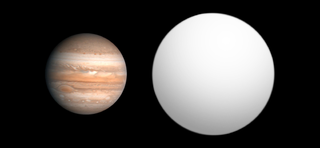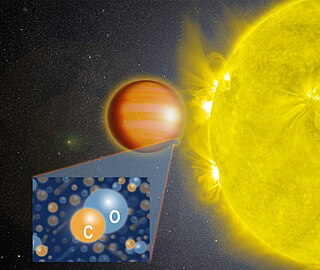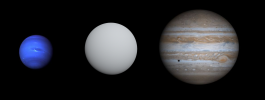Related Research Articles

XO-3b is an exoplanet with about 11.79 times the mass of Jupiter, and it orbits its parent star in about 3.2 days. The radius of this object is 1.217 times that of Jupiter. Astronomers announced their discovery on May 30, 2007, at the American Astronomical Society in Honolulu, Hawaii. Its discovery is attributed to the combined effort of amateur and professional astronomers working together on the XO Project using a telescope located on the Haleakala summit in Hawaii.

TrES-4b is an extrasolar planet, and one of the largest exoplanets ever found, after WASP-12b, WASP-17b, CT Chamaeleontis b, GQ Lupi b and HD 100546 b. It was discovered in 2006, and announced in 2007, by the Trans-Atlantic Exoplanet Survey, using the transit method. It is approximately 1,400 light-years (430 pc) away orbiting the star GSC 02620-00648, in the constellation Hercules.

HAT-P-4b is a confirmed extrasolar planet orbiting the star HAT-P-4 over 1000 light years away in Boötes constellation. It was discovered by transit on October 2, 2007, which looks for slight dimming of stars caused by planets that passed in front of them. It is the fourth planet discovered by the HATNet Project. It is also called BD+36 2593b, TYC 2569-01599-1b, 2MASS J15195792+3613467b, SAO 64638b.

CoRoT-2b is the second extrasolar planet to be detected by the French-led CoRoT mission, and orbits the star CoRoT-2 at a distance of 700 light years from Earth towards the constellation Aquila. Its discovery was announced on 20 December 2007. After its discovery via the transit method, its mass was confirmed via the radial velocity method.

WASP-6b is an extrasolar planet approximately 600 light years away in the constellation Aquarius. It was discovered in 2008, by the WASP survey, by astronomical transit across its parent star WASP-6. This planet orbits only 4% that of Earth-Sun distance. The planet has mass half that of Jupiter, but its insolation has forced a thermal expansion of its radius over that of Jupiter. The planet is an inflated Hot Jupiter. Starspots on the host star WASP-6 helped to refine the measurements of the mass and the radius of the planet.

WASP-8b is an extrasolar planet orbiting the star WASP-8A in the constellation of Sculptor. The star is similar to the Sun and forms a binary star with a Red dwarf star (WASP-8B) of half the Sun's mass that orbits WASP-8A 4.5 arcseconds away. The system is 293 light-years (90 pc) away and is therefore located closer to Earth than other star systems that are known to feature planets similar to WASP-8b. The planet and its parent star were discovered in the SuperWASP batch -6b to -15b. On 1 April 2008, Dr. Don Pollacco of Queen's University Belfast announced them at the RAS National Astronomy Meeting.

HD 80606 b is an eccentric hot Jupiter 190 light-years from the Sun in the constellation of Ursa Major. HD 80606 b was discovered orbiting the star HD 80606 in April 2001 by a team led by Michel Mayor and Didier Queloz. With a mass 4 times that of Jupiter, it is a gas giant. Because the planet transits the host star its radius can be determined using the transit method and was found to be slightly smaller than Jupiter's. Its density is slightly less than Earth's. It has an extremely eccentric orbit like a comet, with its orbit taking it very close to its star and then back out very far away from it every 111 days.

CoRoT-3b is a brown dwarf or massive extrasolar planet with a mass 21.66 times that of Jupiter. The object orbits an F-type star in the constellation of Aquila. The orbit is circular and takes 4.2568 days to complete. It was discovered by the French-led CoRoT mission which detected the dimming of the parent star's light as CoRoT-3b passes in front of it.

HD 17156 b, named Mulchatna by the IAU, is an extrasolar planet approximately 255 light-years away in the constellation of Cassiopeia. The planet was discovered orbiting the yellow subgiant star HD 17156 in April 2007. The planet is classified as a relatively cool hot Jupiter planet slightly smaller than Jupiter but slightly larger than Saturn. This highly-eccentric three-week orbit takes it approximately 0.0523 AU of the star at periastron before swinging out to approximately 0.2665 AU at apastron. Its eccentricity is about the same as 16 Cygni Bb, a so-called "eccentric Jupiter". Until 2009, HD 17156 b was the transiting planet with the longest orbital period.

HAT-P-9b, formally named Alef, is an exoplanet approximately 1500 light years away in the constellation Auriga. This planet was found by the transit method on June 26, 2008. It has a mass 78% that of Jupiter and a radius 140% that of Jupiter. As with most transiting planets, this planet is a hot Jupiter, meaning this Jupiter-like planet orbits extremely close to its parent star, taking only 3.92 days to orbit.

HAT-P-8b is an extrasolar planet located approximately 720 light years away in the constellation of Pegasus, orbiting the 10th magnitude star GSC 02757-01152. This planet was discovered by transit on December 5, 2008. Despite the designation as HAT-P-8b, it is the 11th planet discovered by the HATNet Project. The mass of the planet is 50% more than Jupiter while the radius is also 50% more than Jupiter. The mass of this planet is exact since the inclination of the orbit is known, typical for transiting planets. This is a so-called “hot Jupiter” because this Jupiter-like gas giant planet orbits in a really close torch orbit around the star, making this planet extremely hot. The distance from the star is roughly 20 times smaller than that of Earth from the Sun, which places the planet roughly 8 times closer to its star than Mercury is from the Sun. The “year” on this planet lasts only 3 days, 1 hour, 49 minutes, and 54 seconds, compared with Earth's 365 days, 6 hours, 9 minutes, and 10 seconds in a sidereal year.
CoRoT-2 is a yellow dwarf main sequence star a little cooler than the Sun. This star is located approximately 700 light-years away in the constellation of Aquila. The apparent magnitude of this star is 12, which means it is not visible to the naked eye but can be seen with a medium-sized amateur telescope on a clear dark night.

WASP-18b is an extrasolar planet that is notable for having an orbital period of less than one day. It has a mass equal to 10 Jupiter masses, just below the boundary line between planets and brown dwarfs. In 2023, the James Webb Space Telescope discovered traces of water in the planet. Due to tidal deceleration, it is expected to spiral toward and eventually merge with its host star, WASP-18, in less than a million years. The planet is approximately 3.1 million km from its star, which is about 410 light-years from Earth. A team led by Coel Hellier, a professor of astrophysics at Keele University in England, discovered the exoplanet.

WASP-19b, formally named Banksia, is an exoplanet, notable for possessing one of the shortest orbital periods of any known planetary body: 0.7888399 days or approximately 18.932 hours. It has a mass close to that of Jupiter, but by comparison has a much larger radius ; making it nearly the size of a low-mass star. It orbits the star WASP-19 in the Vela constellation. At the time of discovery it was the shortest period hot Jupiter discovered as planets with shorter orbital periods had a rocky, or metallic composition.
HAT-P-24b is an extrasolar planet discovered by the HATNet Project in 2010 orbiting the F8 dwarf star HAT-P-24. It is a hot Jupiter, with a mass three quarters that of Jupiter and a radius 20% larger.
Kepler-13 or KOI-13 is a stellar triple star system consisting of Kepler-13A, around which an orbiting hot Jupiter exoplanet was discovered with the Kepler spacecraft in 2011, and Kepler-13B a common proper motion companion star which has an additional star orbiting it.
CoRoT-21b is a transiting exoplanet reportedly found by the CoRoT space telescope in 2011. Planetary parameters were published in 2012.

CoRoT-8b is a transiting exoplanet orbiting the K-type main sequence star CoRoT-8 1,050 light years away in the equatorial constellation Aquila. The planet was discovered in April 2010 by the CoRoT telescope.
CoRoT-11b is a transiting Hot Jupiter-sized exoplanet found by the CoRoT space telescope in 2010.
HD 146389, is a star with a yellow-white hue in the northern constellation of Hercules. The star was given the formal name Irena by the International Astronomical Union in January 2020. It is invisible to the naked eye with an apparent visual magnitude of 9.4 The star is located at a distance of approximately 446 light years from the Sun based on parallax, but is drifting closer with a radial velocity of −9 km/s. The star is known to host one exoplanet, designated WASP-38b or formally named 'Iztok'.
References
- ↑ "Notes on CoRoT-18 b" . Retrieved February 25, 2019.
- ↑ "COROT-18 Planets in the system" . Retrieved February 25, 2019.
- ↑ Hébrard, G.; et al. (2011), "Transiting exoplanets from the CoRoT space mission", Astronomy & Astrophysics, 533: A130, arXiv: 1107.2032 , doi:10.1051/0004-6361/201117192
- ↑ "NEW WORLDS ATLAS CoRoT-18 b" . Retrieved February 25, 2019.
- ↑ Albrecht, Simon; Winn, Joshua N.; Johnson, John A.; Howard, Andrew W.; Marcy, Geoffrey W.; Butler, R. Paul; Arriagada, Pamela; Crane, Jeffrey D.; Shectman, Stephen A.; Thompson, Ian B.; Hirano, Teruyuki; Bakos, Gaspar; Hartman, Joel D. (2012), "Obliquities of Hot Jupiter Host Stars: Evidence for Tidal Interactions and Primordial Misalignments", The Astrophysical Journal, 757: 18, arXiv: 1206.6105 , Bibcode:2012ApJ...757...18A, doi:10.1088/0004-637X/757/1/18, S2CID 17174530